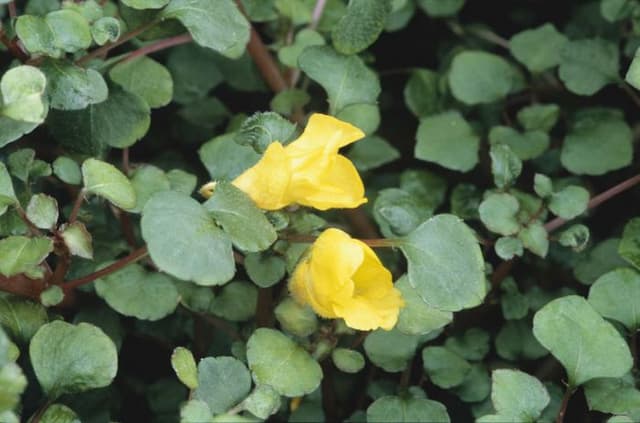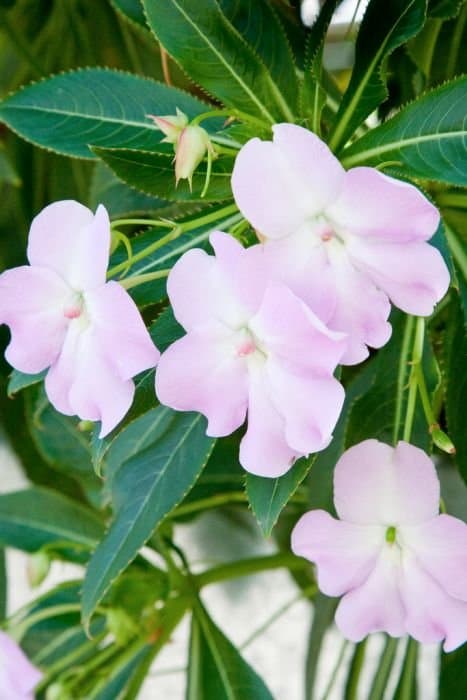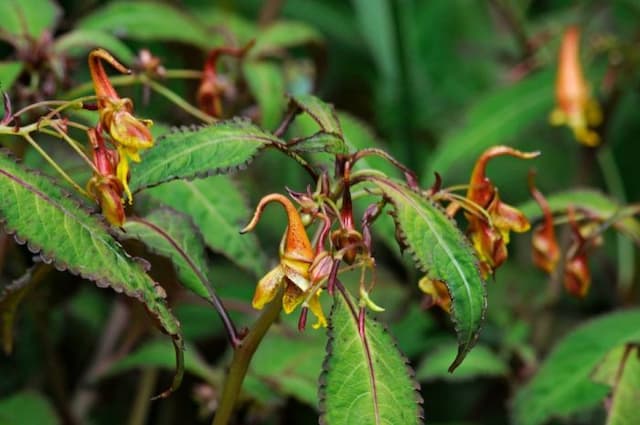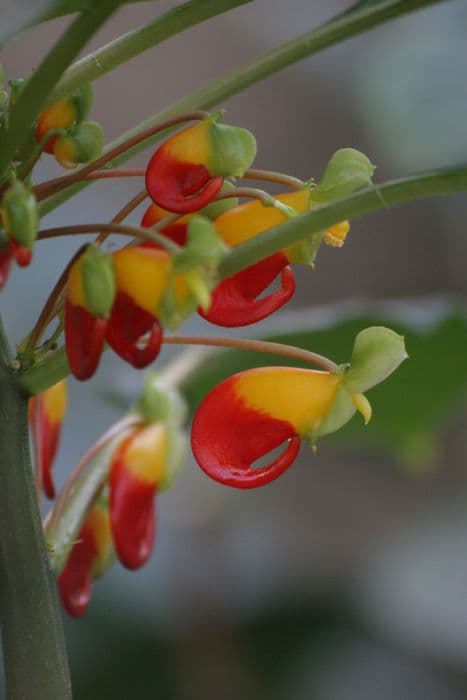New Guinea Impatiens Impatiens Divine Violet (Divine Series) (NG)
![busy lizzie [Divine Violet]](/_next/image?url=https%3A%2F%2Fplants-admin.emdemapps.com%2Fimages%2Fplants%2F%2Fimages%2F604b651b90e59.png&w=3840&q=75)
ABOUT
Impatiens Divine Violet, which belongs to the Divine series, is a vibrant flowering plant known for its striking violet blooms. The flowers of this plant exhibit a rich, deep purple hue that can add a touch of elegance to any garden space. Each bloom has a distinct, slightly curved shape with five petals that fan out from a central point, creating a rounded, symmetrical appearance. The center of the flowers often has a subtle, paler throat, which adds depth to the floral display. The foliage of Impatiens Divine Violet is equally attractive, featuring lush, green leaves that provide a contrasting backdrop for the vivid violet flowers. The leaves are usually glossy with a smooth texture, and they have a rounded to elongated shape with subtle serration on the edges. The overall bushy and verdant appearance of the plant makes it an excellent choice for those looking to create a full and colorful garden or container arrangement. Throughout the blooming season, you can expect Impatiens Divine Violet to produce a profusion of flowers, which can create a continuous carpet of color when planted en masse. The plant is popular for its ability to flourish in shadier areas, where many other colorful blooms may not perform as well. It is commonly used in garden beds, borders, and as a filler in mixed container plantings, bringing a splash of violet to various garden designs.
About this plant
 Names
NamesFamily
Balsaminaceae
Synonyms
Touch-Me-Not, Busy Lizzie, Patience Plant
Common names
Impatiens hawkeri, Impatiens hawkeri W. Bull.
 Toxicity
ToxicityTo humans
Impatiens are generally regarded as safe for humans and are not known to be toxic. There are no well-documented cases of Impatiens causing serious poisoning in people. If ingested in large quantities, they could potentially cause mild stomach upset, but this is rare. It is advisable that no plant material should be eaten unless it is known to be safe for consumption.
To pets
Impatiens are also considered non-toxic to pets. They are not known to cause serious harm if ingested by animals such as dogs and cats. As with humans, consumption of large amounts might result in mild gastrointestinal upset, but significant toxicity is not expected. Always observe your pet for any unusual symptoms and consult a veterinarian if any concerns arise after ingestion.
 Characteristics
CharacteristicsLife cycle
Annuals
Foliage type
Evergreen
Color of leaves
Green
Flower color
Violet
Height
1-1.5 feet (30-45 cm)
Spread
1-1.5 feet (30-45 cm)
Plant type
Herb
Hardiness zones
10
Native area
East Africa
Benefits
 General Benefits
General Benefits- Easy to Grow: Impatiens are known for their ease of care, which makes them suitable for gardeners of all experience levels.
- Shade Tolerance: This plant thrives in shaded areas where other flowers might not grow as well, allowing for colorful blooms in less sunny gardens.
- Continuous Blooming: Impatiens Divine Violet provides long-lasting color with blooms that typically last from spring until the first frost.
- Versatility: Suitable for both garden beds and containers, allowing for flexible gardening designs and uses.
- Attracts Pollinators: While not their primary benefit, impatiens can attract certain pollinators, adding to garden biodiversity.
- Low Maintenance: Impatiens generally have minimal pruning and grooming requirements.
- Vibrant Color: The Divine Violet variety offers a vibrant purple hue that can add a splash of color to any garden palette.
- Drought Resistance: Though they prefer consistent moisture, impatiens can tolerate short periods of drought better than some other shade-loving plants.
- Compact Growth: Their compact size makes them ideal for borders, edging, and small garden spaces.
 Medical Properties
Medical Properties- This plant is not used for medical purposes.
 Air-purifying Qualities
Air-purifying QualitiesThis plant is not specifically known for air purifying qualities.
 Other Uses
Other Uses- Impatiens in art: Impatiens flowers, with their vivid colors and shapes, are often used as subjects in botanical art and illustrations, capturing their essence through various mediums of art such as watercolor, photography, or digital art.
- Photography practice: The vibrant violet color of the Impatiens Divine can provide an excellent opportunity for amateur photographers to practice macro photography and color balance.
- Educational tool: Teachers and educators might employ these plants to help young students learn about plant biology, pollination, and the life cycle of flowers through observation and hands-on activities.
- Feng Shui: Some practitioners use Impatiens to create positive energy flow in gardens and homes according to Feng Shui principles due to their lush growth and bright, cheerful flowers.
- Culinary presentation: Although not for consumption, the visual appeal of the Impatiens flowers can be used to enhance the presentation of dishes, especially in high-end culinary settings, as long as the flowers do not come into contact with the food.
- Stress relief: Gardeners may find the act of tending to and caring for Impatiens Divine Violet to be a form of stress relief and a way to reconnect with nature.
- Color theory demonstration: The vivid purple hues of the Divine Series can be utilized in art and design classes to demonstrate the use of color in compositions and the visual effects of complementary colors.
- Plant companionship: Placing Impatiens alongside other shade-loving plants can help create a diverse ecosystem that supports beneficial insects and increases overall plant health.
- Crafting pressed flowers: The colorful petals can be dried and pressed to use in craft projects such as making bookmarks, greeting cards, or decoupage.
- Event decor: Impatiens Divine Violet can be used in event decoration to provide a natural and colorful aesthetic to weddings, garden parties, or other social events with their striking purple blooms.
Interesting Facts
 Feng Shui
Feng ShuiThe Balsam is not used in Feng Shui practice.
 Zodiac Sign Compitability
Zodiac Sign CompitabilityThe Balsam is not used in astrology practice.
 Plant Symbolism
Plant Symbolism- Impatience: As the name "Impatiens" suggests, this plant can symbolize impatience or a restless desire for quick results.
- Affection: Impatiens flowers have a delicate and appealing look that can convey affection and fondness.
- Motherly Love: The nurturing and proliferous nature of the plant is often associated with the tenderness and care characteristic of motherly love.
- Perseverance: Despite their delicate appearance, Impatiens are hearty plants that can bounce back from adversity, symbolizing resilience and perseverance.
 Water
WaterThe New Guinea Impatiens should be watered thoroughly when the top inch of soil feels dry to the touch, generally every few days, depending on environmental conditions. It is best to water these plants in the morning using a watering can or hose set to a gentle spray, to avoid waterlogging the soil and to give the foliage time to dry out over the course of the day. Ensure there is proper drainage to prevent root rot. Indoors, they might require less water, about once every week, and it's crucial not to let them sit in water. Water with approximately one gallon of water per square foot every week, adjusting as needed for temperature and humidity.
 Light
LightNew Guinea Impatiens prefer bright, indirect light or dappled shade. They can tolerate morning sunlight but should be protected from the intense afternoon sun to prevent leaf scorch. The ideal spot for these plants is in an area that receives filtered sunlight throughout the day or under the light shade of trees where they can be exposed to the softer rays of the sun.
 Temperature
TemperatureNew Guinea Impatiens thrive in temperatures between 60 and 85 degrees Fahrenheit. They can tolerate a minimum temperature of 50 degrees Fahrenheit but anything lower could cause damage or stunt growth. The ideal temperature range ensures vibrant blooms and healthy foliage, so placement should be considered to avoid exposure to extreme conditions outside of this range.
 Pruning
PruningNew Guinea Impatiens should be pruned to encourage bushier growth and more flowers. Pinch back the tips of the stems regularly, especially early in the season. They can be pruned more heavily in late winter or early spring before new growth begins. Remove dead or yellowing leaves and spent flowers to maintain plant health and appearance.
 Cleaning
CleaningAs needed
 Soil
SoilImpatiens, commonly known as Busy Lizzies, thrive best in a well-draining, peat-based potting mix. Aim for a pH between 6.0 and 6.5 for optimal growth.
 Repotting
RepottingBusy Lizzies should be repotted annually in spring to refresh the soil and accommodate growth.
 Humidity & Misting
Humidity & MistingBusy Lizzies prefer high humidity levels, generally around 50-70%.
 Suitable locations
Suitable locationsIndoor
Place Busy Lizzies in bright, indirect light indoors.
Outdoor
Place in partial shade with moist soil outdoors.
Hardiness zone
10-11 USDA
 Life cycle
Life cycleThe Impatiens Divine Violet, commonly known as New Guinea impatiens, begins its life cycle as a seed which, when planted in warm, moist soil and provided with the right conditions, germinates typically within 1-3 weeks. Seedlings emerge and the plant enters a vegetative state, during which leaves and stems develop rapidly given adequate light and water. As the plant matures, it begins to produce vibrant violet flowers, entering the flowering stage which can occur as early as 10 weeks after sowing under optimal conditions. During its blooming period, which can extend throughout the warm months provided it isn't exposed to freezing temperatures, the plant may attract pollinators, although many New Guinea impatiens are self-fertile. When the flowers fade, seed pods may form, which eventually dry and split open to disperse seeds, completing the reproductive cycle. The plant is typically grown as an annual in colder climates, meaning it completes its life cycle within one growing season, but can be perennial in tropical or warm regions where it can survive year-round.
 Propogation
PropogationPropogation time
Spring-Summer
Propogation: Impatiens, particularly the Impatiens Divine Violet belonging to the Divine Series, are most commonly propagated through seed. The ideal time for sowing seeds is late winter to early spring, as these plants are sensitive to cold and need a warm growing season to thrive. To propagate, fill a seed-starting tray with moist, well-draining soil and sprinkle the tiny seeds on top, lightly pressing them into the soil surface. Do not cover them with more soil as they need light to germinate. Place the tray in a warm spot with plenty of indirect light and keep the soil consistently moist. Seeds typically germinate within 10 to 21 days at a temperature of about 70 to 75 degrees Fahrenheit (21 to 24 degrees Celsius). After the seedlings grow and develop a set of true leaves, they can be transplanted to individual pots or directly to the garden once the threat of frost has passed and the soil has warmed.




![Busy lizzie [SunPatiens Compact Orange]](/_next/image?url=https%3A%2F%2Fplants-admin.emdemapps.com%2Fimages%2Fplants%2F%2Fimages%2F604b5ef883e70.png&w=640&q=75)
![Busy lizzie [SunPatiens Vigorous Magenta]](/_next/image?url=https%3A%2F%2Fplants-admin.emdemapps.com%2Fimages%2Fplants%2F%2Fimages%2F604b622adf631.png&w=640&q=75)


![Busy lizzie [Magnum Wild Salmon]](/_next/image?url=https%3A%2F%2Fplants-admin.emdemapps.com%2Fimages%2Fplants%2F%2Fimages%2F604b589ecbd54.png&w=640&q=75)
